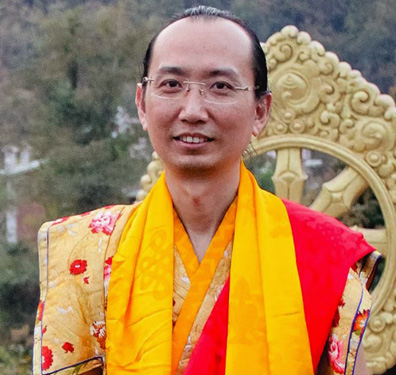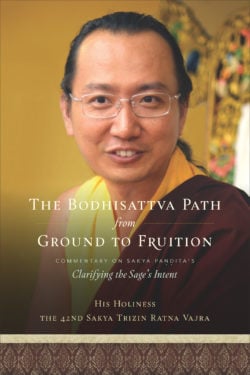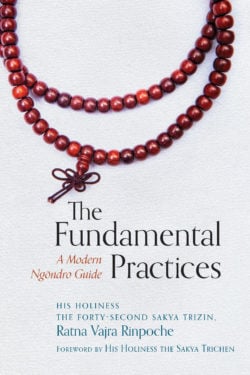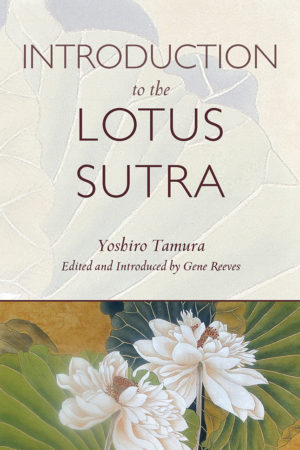His Holiness the 42nd Sakya Trizin

His Holiness the Forty-Second Sakya Trizin, Ratna Vajra Rinpoche, holds the esteemed position of the forty-second Sakya throne holder within the Sakya school of Tibetan Buddhism. He is renowned for his profound knowledge and the clarity of his teachings, making him one of the most well-regarded lineage holders in the Tibetan Buddhist tradition. He hails from the acclaimed Khön family, known for producing successive generations of exceptional Buddhist masters. From a young age, His Holiness received extensive teachings, empowerments, and transmissions in both sutra and tantra from his father and numerous other esteemed teachers. After completing rigorous philosophical studies at Sakya College in India, he earned the kachupa degree. Embarking on meditation retreats from the age of twelve, including the Hevajra retreat, a key tantric practice within the Sakya school, with great humility, he travels extensively to offer teachings and empowerments to students worldwide upon their request.
Books, Courses & Podcasts
The Bodhisattva Path from Ground to Fruition
Discover profound teachings on the Buddhist path from His Holiness the 42nd Sakya Trizin Ratna Vajra, one of Tibetan Buddhism’s most prominent leaders.
His Holiness Ratna Vajra Rinpoche is one of Tibetan Buddhism’s most highly qualified teachers, having received all the major empowerments, transmissions, and teachings directly from his father, Gongma Trichen Rinpoche, the forty-first Sakya throne holder and one of the most senior teachers of the Sakya tradition. Following in the footsteps of his forefathers, His Holiness is renowned for the purity of his transmission, always taking great care to offer to his disciples the teachings as he faithfully received them. To the great fortune of his non-Tibetan-speaking students, His Holiness is also fluent in English, giving them a direct access to his teachings.
In this book, His Holiness offers profound commentary on Sakya Paṇḍita’s Clarifying the Sage’s Intent, one of Tibet’s most revered works on the bodhisattva path. Elucidating Sakya Paṇḍita’s teachings in exquisite detail, His Holiness describes the ground of Buddhist practice as the spiritual potential for liberation that is present in the hearts of all beings. He outlines the foundational practices of taking refuge and cultivating the resolve to become awakened, before detailing the six perfections, the levels of accomplishment of bodhisattvas, and the fruition of practice as a fully awakened buddha.
Light of Samantabhadra
A gateway to Indian philosophy and its explication in Tibet.
Among the many works produced in the rich philosophical tradition of India’s classical age, few have had more impact than Dharmakīrti’s Commentary on Valid Cognition (Pramāṇavārttika). Composed in India in the seventh century, it became the cornerstone for the study of logic and epistemology in the Tibetan Buddhist tradition.
This work translated here is by one of the premier scholars of the Sakya school, Gorampa Sönam Sengé (1429–89). It illuminates the first two chapters of Dharmakīrti’s work, those on using inference to enlighten oneself (svārthānumāna) and on establishing valid cognition (pramāṇasiddhi) both to determine the authority of the Buddha as a valid teacher and to eliminate the cognitive obstacles to awakening. The root text is composed in compact verses, and these are translated here along with Gorampa’s word-by-word commentary that reveals their often veiled meanings. These chapters explore key issues in the philosophy of language and the nature of conventional designation, the way to employ sound reasoning, the proof of past and future lives, and the way to eliminate the view of self. In the skilled hands of translator Gavin Kilty, these insights are made accessible.
Light of Samantabhadra is the first volume in a new academic series from Wisdom and the Khenpo Appey Foundation. The Khenpo Appey Collection of Sakya Classics aspires to fulfill Khenchen Appey Rinpoche’s vision of making important and authoritative Sakya works accessible to English-speaking audiences. This series, conceived by the Khenpo Appey Foundation and published by Wisdom Publications, will contain translations of texts central to Tibetan Buddhist study composed by influential Sakya masters to provide a holistic and comprehensive presentation of Buddhist thought and philosophy.
The Fundamental Practices
A wise and warm guide to the preliminary practices that lay the fundamental groundwork for traversing the path to buddhahood.
When we start on the transformational journey to enlightenment, we need a strong foundation in core Buddhist principles and practices to set us on the right track. The ngöndro, or preliminary practices, are that very foundation; they not only prepare us for advanced practice but serve us in all we do. In this guide to the common and uncommon preliminary practices, His Holiness the Forty-Second Sakya Trizin, Ratna Vajra Rinpoche, expertly gives us the grounded, practical, and illuminating teachings we need to set out on the path to buddhahood. Newcomers and seasoned practitioners alike will find practical guidance and profound wisdom to support them through their exploration of the preliminary practices.
The common preliminary practices are the four thoughts that turn the mind away from the suffering of samsara and toward the Dharma: remembering the shortcomings of samsara, remembering the preciousness of a human rebirth, remembering impermanence, and remembering the law of karma. These teachings are shared among traditions and will accompany us all the way to buddhahood. The five uncommon preliminary practices are core to further Mahayana and Vajrayana practice: going for refuge in the Buddha, Dharma, and Sangha; developing bodhichitta, the enlightened mind; Vajrasattva practice, which clears negative karma; mandala offering, which will help us accumulate merit; and guru yoga, which facilitates our realization of the nature of mind.
By using this guide, we can develop a deeper understanding of what Dharma practice truly encompasses and how we can authentically engage in it. His Holiness the Forty-Second Sakya Trizin invites us to appreciate the profound significance of these preliminary practices and experience the transformative benefits they offer—for both ourselves and all sentient beings.




